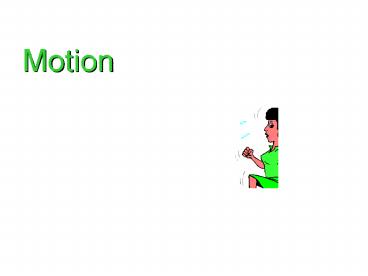Motion - PowerPoint PPT Presentation
1 / 22
Title:
Motion
Description:
Motion Definition Motion is Relative Relative it is described compared to a REFERENCE POINT Types of Motion Uniform motion - constant speed in a straight line ... – PowerPoint PPT presentation
Number of Views:209
Avg rating:3.0/5.0
Title: Motion
1
Motion
2
Definition
- Event that involves a change in the position or
location of something.
3
Motion is Relative
- Relative it is described compared to a
REFERENCE POINT
4
Types of Motion
- Uniform motion - constant speed in a straight
line - Accelerated motion motion that is changing in
speed or direction - Circular motion - speed is constant but the
direction of motion is changing continuously
5
Scalar Quantities
- Show magnitude amount only
- Speed, time, temperature
6
Vector Quantities
- Show magnitude and direction
- Velocity, acceleration, force
- May be graphically represented
- Arrows
7
SpeedAverage Speed
- Comparison of time and distance
- A scalar quantity magnitude only
- Distance traveled per unit time
- S d / t
- T d / s
- D s x t
8
SpeedInstantaneous Speed
- Speed at any instant
9
SpeedConstant Speed
- Speed that does not change
- Instantaneous speed that does not change
10
Velocity
- Speed AND direction
- A vector quantity magnitude direction
11
Acceleration
- A change in velocity
- Speeding up
- Positive acceleration
- Slowing down
- Negative acceleration
- Deceleration
- Changing direction
12
Forces
- Pushes or pulls
- May cause acceleration changes in motion
- May also cause changes in shape
13
Balanced Forces
- All forces acting on an object are equal
- There is no motion
14
Unbalanced Forces
- All forces acting on an object are not equal
- One or more force is stronger than others
- Motion occurs
15
Net Force
- The sum of all forces acting on an object
- A net force of 0
- No motion
- A net force of more than 0
- Motion occurs
16
Resultant
- Another term for net force
17
Friction
- Force that slows down motion
- Air resistance creates friction in most situations
18
Gravity
- Force that attracts all objects toward each other
- More mass more gravity
- Acceleration because of gravity is 9.8 m/s/s
- All objects accelerate at the same rate
19
Newton's Laws
- Describe motion and changes in motion
20
First Law of Motion
- Law of inertia
- Objects at rest not moving will not begin to
move until a force acts on them - Objects in motion will not stop moving until a
force acts on them - Objects with more mass have more inertia
- Bigger objects are harder to start and stop
21
Second Law of Motion
- Law of acceleration
- A force is needed to change motion
- Objects accelerate in the direction of the force
- The more force applied, then more acceleration
- The more mass an object has, the more force is
needed to accelerate the object
22
Third Law of Motion
- Law of action-reaction
- Forces occur in pairs
- The forces are equal and opposite
- One force is an action force
- The other force is a reaction force
- The forces act on different objects































